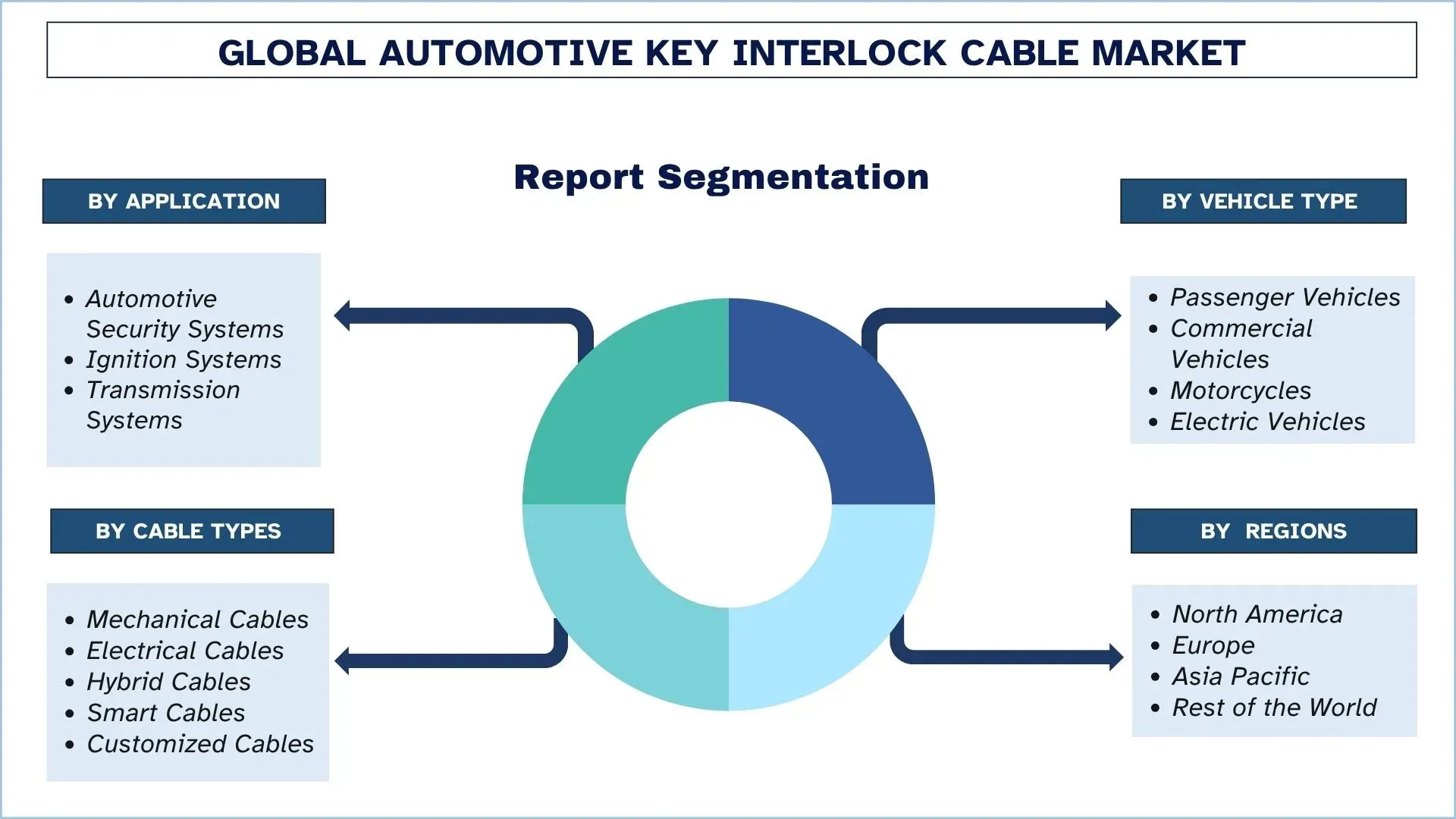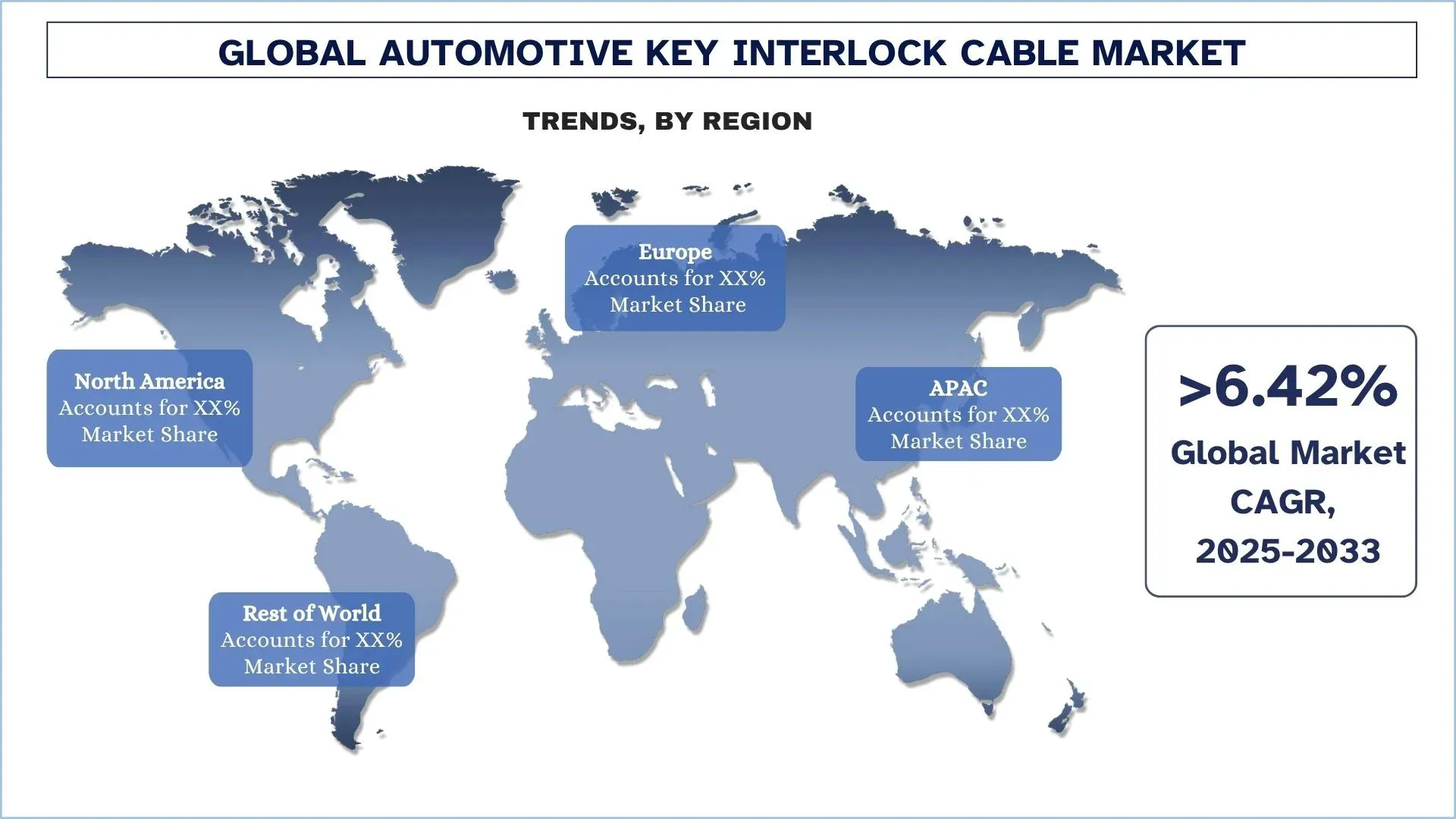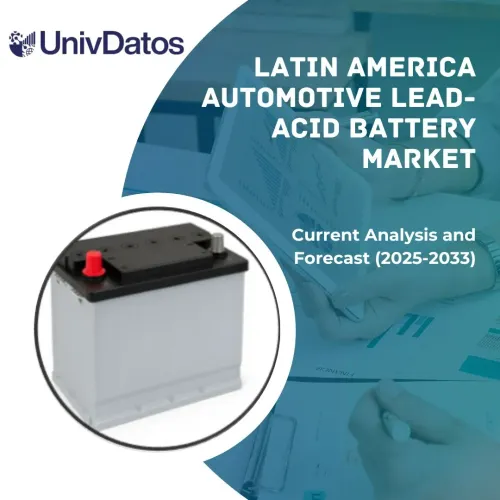- Home
- About Us
- Industry
- Services
- Reading
- Contact Us
Automotive Key Interlock Cable Market: Current Analysis and Forecast (2025-2033)
Emphasis on By Application (Automotive Security Systems, Ignition Systems, Transmission Systems); By Vehicle Type (Passenger Vehicles, Commercial Vehicles, Motorcycles, Electric Vehicles); By Cable Types (Mechanical Cables, Electrical Cables, Hybrid Cables, Smart Cables, Customized Cables); and Region/Country

Automotive Key Interlock Cable Market Size & Forecast
The Automotive Key Interlock Cable market was valued at USD 1.92 billion in 2024 and is expected to grow at a strong CAGR of 6.42% for the forecast period (2025- 2033F) due to the increasing vehicle production, rising demand for vehicle safety systems, and technological advancements in automotive components.
Automotive Key Interlock Cable Market Analysis
The automotive key interlock cable market is growing due to the convergence of several factors. The tightening regulations include safety standards such as the United States' Federal Motor Vehicle Safety Standards (FMVSS), the European Union's General Safety Regulations, and China standards, which require vehicle manufacturers to include interlocks that prevent the removal of keys or the vehicle from being shifted until stationary to reduce road traffic accidents. The shift to common automatic transmissions, electric vehicles (EVs), and semi-autonomous vehicles has created demand for interlock cables that will replicate performance but have a smaller footprint and lighter weight, as well as more frequent electronic components in vehicle design replace the mechanical “shift-by-wire” components. Technology advancements in material strength (high-strength steel, polymers) and corrosion-resistant alloys are improving weight efficiency while improving durability for interlock cables that are still up to the task of supporting ICE or EV-type motivations. Further demand for vehicles and fleet capacity is growing in conjunction with the development in India and China, as well as the general demand for older vehicles' replacement parts and refurbishments.
Automotive Key Interlock Cable Market Trends
This section discusses the key market trends influencing the various segments of the Automotive Key Interlock Cable market as identified by our research experts.
The Rise of Electric Vehicles
The increase in electric vehicles (EVs) has a substantial impact on the automotive key interlock cable market, particularly in technologically advanced countries like the United States. EVs are designed with electronic drive systems, such as the shift-by-wire mechanism, compared to traditional internal combustion engine (ICE) vehicles. As EV technology continues to advance and integrate technologies like autonomous driving assistance and an increased number of digital control modules, the need for more complex safety and control systems will increase in the EV sector. Many EV manufacturers have chosen to offer electronic or hybrid interlock cables that can accommodate smart vehicle systems while having appropriate physical fail-safes in place to protect the user. The increase in incentives from governments and interest from consumers for clean energy vehicles will only continue to drive the adoption of EVs, thus increasing the size of the market for automotive safety components. As safety, automation, and user experience become centre-stage in the design approaches to EVs, the key interlock cable is becoming an integral component due to its substantial share of the increasing demand.
Automotive Key Interlock Cable Industry Segmentation
This section provides an analysis of the key trends in each segment of the global Automotive Key Interlock Cable market report, along with forecasts at the global, regional, and country levels for 2025-2033.
The Transmission Systems category dominates the Automotive Key Interlock Cable market.
Based on application, the market is segmented into security systems, ignition systems, and transmission systems. The global automatic transmission systems are experiencing rapid growth in the automotive key interlock cable market due to the simultaneous adoption of automatic transmission systems, which require more developed shift‑interlock systems, enabling safety and compliance measures within local regulations. As automatic transmissions become the standard in passenger automotive and commercial, and electric vehicle segments, demand is set to continue to escalate, as stricter safety regulations enforce interlock systems in new vehicles across the globe. The shift in automotive design towards lightweight, high-tensile, corrosion-resistant materials, modular designs with potential for electronic value in a shift‑by‑wire system, ensures reliability and is extremely adaptable to legions of single and multi-vehicle designs in EVs and those fitted with ADAS systems. As automatic transmissions proliferation associated with tightening safety regulations and modern technology adoption increases, automakers' reliance on more robust and complex interlock systems makes the automatic shift interlock cable market a crucial and rapidly expanding part of the powertrain and safety architectures of automotive systems.
The passenger vehicles category dominates the Automotive Key Interlock Cable market.
Based on vehicle type, the market is segmented into passenger vehicles, commercial vehicles, motorcycles, and electric Vehicles. Passenger vehicles held a significant share of the automotive key interlock cable market due to the growing demand for safety features and advanced technology in personal mobility. Interlock cables in passenger vehicles have varied uses, including in transmission park-lock systems, tailgate actuation, and column shifter engagement. Electric Vehicles are a notable trend, highlighting an overall shift toward sustainable modes of mobility being adopted globally. As the automotive industry shifts to electrification, the demand for interlock cables in electric vehicles is expected to grow, creating an opportunity for innovation and expansion in the automotive key interlock cable market as demand for adaptable drivetrains, electronic shift mechanisms, and improved safety systems rises.

North America held a dominant share of the Automotive Key Interlock Cable market in 2024
The North American Automotive Key Interlock Cable market is driven by a combination of stringent safety regulations, technology-based innovation, and a willingness to invest in local industry. The increased leadership of the region in EV adoption, as well as the demand for smart-key systems that integrate NFC/BLE through the Cloud for access in interlock systems, makes the use of "smart", digital cables not only relevant but an expectation. North American consumer expects anti-theft capabilities of their automobiles, which has forced manufacturers of Interlocks to develop mechanically "smarter" and electronically sound interlock products.
The U.S. held a dominant share of the North American Automotive Key Interlock Cable market in 2024.
In the United States, the automotive key interlock cable market is growing rapidly due to a range of regulatory, technological, and industry-specific factors. The most significant driver of this growth is the stringent vehicle safety regulations put in place by U.S. authorities and vehicle safety organizations that mandated that interlock systems be in place to prevent accidental vehicle movement and ensure a key cannot be removed until the transmission is in "Park". This safety requirement has led to widespread use of key interlock cables in new vehicles and replacement interlock cables in the aftermarket. Technical developments in the automotive sector, including electric vehicles (EVs) and smart cars, have also contributed to market growth due to the complexity of the vehicle and the integration of electronic and safety systems within the vehicle. The use of electronic control and sensors in vehicles where interlock cables are expected further drives the development of key interlock cables. Enhanced vehicle security and efficiency are also increasingly in demand from consumers, and therefore, manufacturers/automakers are developing interlock cables that work with these features.

Automotive Key Interlock Cable Competitive Landscape
The Automotive Key Interlock Cable Market is competitive and fragmented, with several global and international market players. The key players are adopting different growth strategies to enhance their market presence, such as partnerships, agreements, collaborations, new product launches, geographical expansions, and mergers and acquisitions.
Top Automotive Key Interlock Cable Companies
The major players operating in the market are TE Connectivity plc, Leoni AG (L2-beteiligungs GmbH), Aptiv PLC, Bosch Limited (Robert Bosch Internationale Beteiligungen AG), FURUKAWA AUTOMOTIVE SYSTEMS INC. (Furukawa Electric Co., Ltd.), INGAR ELECTRONICS PVT LTD, RENHOTEC EV, HI-LEX Corporation, Safety Control Cable Ind. Co.,Ltd (HSH Group), and Cablecraft Motion Controls LLC (Cable Manufacturing & Assembly Co. Inc.).
Automotive Key Interlock Cable Market News
On 25 Jun 2025, ASK Automotive Limited announced the formation of a joint venture, T.D. Holding GMBH (TDH) is aimed at manufacturing, marketing, and selling sunroof control cables and helix cables for passenger vehicles.
On 11th July 2024, LEONI announced the launch of the new product called LEONI LIMEVERSE, that are the new automotive cables for the future. They may significantly lower the CO2 footprint by around 50 percent compared to a conventional vehicle and charging cables.
Automotive Key Interlock Cable Market Report Coverage
Report Attribute | Details |
Base year | 2024 |
Forecast period | 2025-2033 |
Growth momentum | Accelerate at a CAGR of 6.42% |
Market size 2024 | USD 1.92 billion |
Regional analysis | North America, Europe, APAC, Rest of the World |
Major contributing region | Asia-Pacific is expected to grow at the highest CAGR during the forecasted period. |
Key countries covered | U.S., Canada, Germany, United Kingdom, Spain, Italy, France, China, Japan, and India |
Companies profiled | TE Connectivity plc, Leoni AG (L2-beteiligungs GmbH), Aptiv PLC, Bosch Limited (Robert Bosch Internationale Beteiligungen AG), FURUKAWA AUTOMOTIVE SYSTEMS INC. (Furukawa Electric Co., Ltd.), INGAR ELECTRONICS PVT LTD, RENHOTEC EV, HI-LEX Corporation, Safety Control Cable Ind. Co.,Ltd (HSH Group), and Cablecraft Motion Controls LLC (Cable Manufacturing & Assembly Co. Inc.). |
Report Scope | Market Trends, Drivers, and Restraints; Revenue Estimation and Forecast; Segmentation Analysis; Demand and Supply Side Analysis; Competitive Landscape; Company Profiling |
Segments Covered | By Application, By Vehicle Type, By Cable Types, By Region/Country |
Reasons to buy the Automotive Key Interlock Cable Market report:
The study includes market sizing and forecasting analysis validated by authenticated key industry experts.
The report briefly reviews overall industry performance at a glance.
The report covers an in-depth analysis of prominent industry peers, primarily focusing on key business financials, product portfolios, expansion strategies, and recent developments.
Detailed examination of drivers, restraints, key trends, and opportunities prevailing in the industry.
The study comprehensively covers the market across different segments.
Deep dive regional-level analysis of the industry.
Customization Options:
The Global Automotive Key Interlock Cable Market can be customized by requirement or any other market segment. Besides this, UnivDatos understands that you may have your own business needs; hence, feel free to contact us to get a report that completely suits your requirements.
Table of Content
Research Methodology for the Automotive Key Interlock Cable Market Analysis (2023-2033)
We analyzed the historical market, estimated the current market, and forecasted the future market of the global automotive key interlock cable market to assess its application in major regions worldwide. We conducted exhaustive secondary research to gather historical market data and estimate the current market size. To validate these insights, we carefully reviewed numerous findings and assumptions. Additionally, we conducted in-depth primary interviews with industry experts across the automotive key interlock cable value chain. After validating market figures through these interviews, we used top-down and bottom-up approaches to forecast the overall market size. We then employed market breakdown and data triangulation methods to estimate and analyze the market size of industry segments and subsegments:
Market Engineering
We employed the data triangulation technique to finalize the overall market estimation and derive precise statistical numbers for each segment and sub-segment of the global automotive key interlock cable market. We split the data into several segments and sub-segments by analyzing various parameters and trends, including application, vehicle type, cable types, and regions within the global automotive key interlock cable market.
The main objective of the Global Automotive Key Interlock Cable Market Study
The study identifies current and future trends in the global automotive key interlock cable market, providing strategic insights for investors. It highlights regional market attractiveness, enabling industry participants to tap into untapped markets and gain a first-mover advantage. Other quantitative goals of the studies include:
Market Size Analysis: Assess the current forecast and market size of the global automotive key interlock cable market and its segments in terms of value (USD).
Automotive Key Interlock Cable Market Segmentation: Segments in the study include areas of application, vehicle type, cable types, and regions.
Regulatory Framework & Value Chain Analysis: Examine the regulatory framework, value chain, customer behavior, and competitive landscape of the automotive key interlock cable industry.
Regional Analysis: Conduct a detailed regional analysis for key areas such as Asia Pacific, Europe, North America, and the Rest of the World.
Company Profiles & Growth Strategies: Company profiles of the Automotive Key Interlock Cable market and the growth strategies adopted by the market players to sustain the fast-growing market.
Frequently Asked Questions FAQs
Q1: What is the Automotive Key Interlock Cable market's current size and growth potential?
The Automotive Key Interlock Cable market was valued at USD 1.92 billion in 2024 and is expected to grow at a CAGR of 6.42% during the forecast period (2025-2033).
Q2: Which segment has the largest share of the Automotive Key Interlock Cable market by application?
The transmission systems are experiencing rapid growth in the automotive Key Interlock Cable market due to the simultaneous adoption of automatic transmission systems, which require more developed interlock systems, enabling safety and compliance measures within local regulations.
Q3: What are the driving factors for the growth of the Automotive Key Interlock Cable market?
• Increasing Vehicle Production: Expanding automotive production in regions like Asia-Pacific, North America, and Europe drives higher demand for all automotive components, including key interlock cables. OEMs are sourcing more cables as part of standard vehicle safety packages.
• Rising Demand for Vehicle Safety Systems: Government regulations and consumer awareness are pushing automakers to integrate safety systems like key interlock mechanisms. These systems help prevent unintended vehicle movement, enhancing occupant and pedestrian safety.
• Technological Advancements in Automotive Components: Innovations in materials and cable design are improving the durability and efficiency of interlock cables. Lightweight, corrosion-resistant cables are becoming more attractive to manufacturers focused on performance and compliance.
Q4: What are the emerging technologies and trends in the Automotive Key Interlock Cable market?
• Rise of Electric Vehicles (EVs): EVs, which often come with unique gear mechanisms, still require interlock safety features adapted for their systems. The EV boom is creating demand for specially designed interlock cables.
• Shift Toward Modular and Compact Cable Design: Manufacturers are developing compact and modular interlock cables to save space and reduce weight. This helps improve vehicle efficiency and assembly flexibility.
Q5: What are the key challenges in the Automotive Key Interlock Cable market?
• Volatility in Raw Material Prices: Fluctuations in the prices of steel, plastics, and other materials can increase production costs. This affects profit margins, especially for small and mid-size manufacturers.
• Stringent Certification and Testing Standards: Complying with international safety and quality standards requires significant investment in R&D and testing. Smaller players may struggle to keep up, limiting their market access.
Q6: Which region dominates the Automotive Key Interlock Cable Market?
The North American Automotive Key Interlock Cable market is driven by a combination of stringent safety regulations, technology-based innovation, and a willingness to invest in local industry.
Q7: Who are the key players in the Automotive Key Interlock Cable market?
Some of the Leading companies in Automotive Key Interlock Cable are:
• TE Connectivity plc
• Leoni AG (L2-beteiligungs GmbH)
• Aptiv PLC
• Bosch Limited (Robert Bosch Internationale Beteiligungen AG)
• FURUKAWA AUTOMOTIVE SYSTEMS INC. (Furukawa Electric Co., Ltd.)
• INGAR ELECTRONICS PVT LTD
• RENHOTEC EV
• HI-LEX Corporation
• Safety Control Cable Ind. Co.,Ltd (HSH Group)
• Cablecraft Motion Controls LLC (Cable Manufacturing & Assembly Co. Inc.)
Q8: What are the key investment opportunities in the global Automotive Key Interlock Cable industry?
The key investment opportunity in the global Automotive Key Interlock Cable industry lies in developing smart, EV-compatible interlock systems leveraging advanced materials, IoT diagnostics, and electronic integration to meet the rising demand for safety, connectivity, and electrified powertrains.
Q9: How are mergers, acquisitions, and brand collaborations shaping the Automotive Key Interlock Cable landscape?
Mergers, acquisitions, and strategic collaborations are reshaping the Automotive Key Interlock Cable industry by enabling Tier 1 suppliers like Orscheln, Kongsberg, Dura, HI Lex, and Cablecraft to rapidly integrate new technologies ranging from sustainable materials and modular systems to smart, electronically enhanced cables while scaling production and expanding global reach through consolidated R&D, manufacturing, and OEM partnerships.
Related Reports
Customers who bought this item also bought










